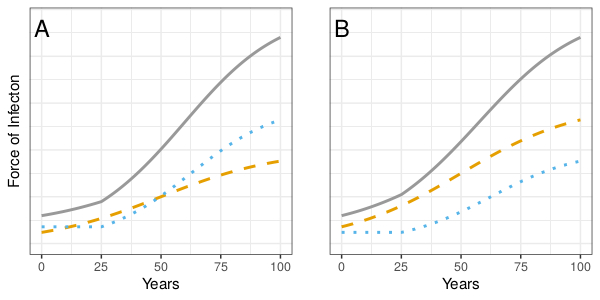Transmission Mechanisms
Transmission occurs from the ingestion of CWD prions, which results from numerous secretion pathways including:
• saliva
• blood
• urine
• feces
• antler velvet
Evidence suggests that direct contacts likely drive disease transmission more than indirect contacts, at least during the early phase of the epizootic. Grear et al (2010) [7] found that CWD infection was significantly increased by an infected adult female white-tailed deer within matrilineal groups but was only slightly increased by less-related infected females with overlapping home-ranges. Direct contact rates are much higher within matrilineal groups than between groups, even when accounting for degree of shared space.
Environmental transmission likely influences the transmission dynamics of CWD, although practicalities of distinctly measuring environmental transmission hinders empirical evaluation. As prevalence increases, shedding of prions into the environment increases, and transmission dynamics may change from direct contact being the most important driver to environmental transmission becoming increasingly important. Both direct and environmental transmission are likely to be additive forces contributing to high CWD transmission, but disease dynamics may differ depending on their magnitude of relative importance.

Cervids are also known to aggregate in feed lots, baiting sites, and mineral licks, that could facilitate transmission by depositing infectious secretions into the environment and increasing direct contacts. Cross-species transmission is likely to be environmentally mediated, because different cervid species do not commonly interact, even in areas with overlapping distributions. CWD transmission is considered primarily horizontal rather than vertical. Low prevalence rates in young deer suggest that vertical transmission is unlikely to play a role in disease dynamics and infection patterns.
